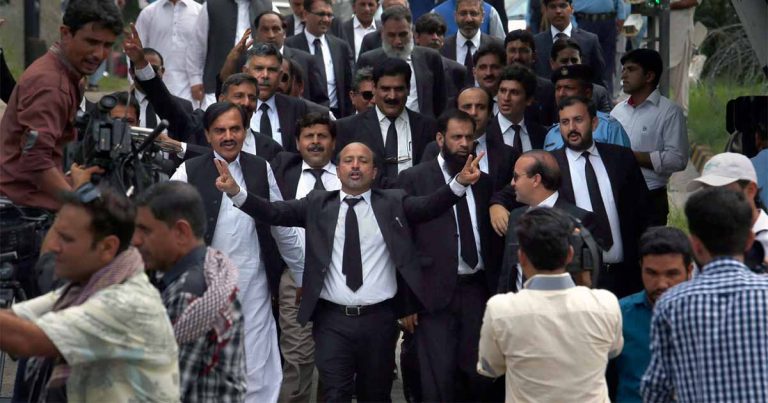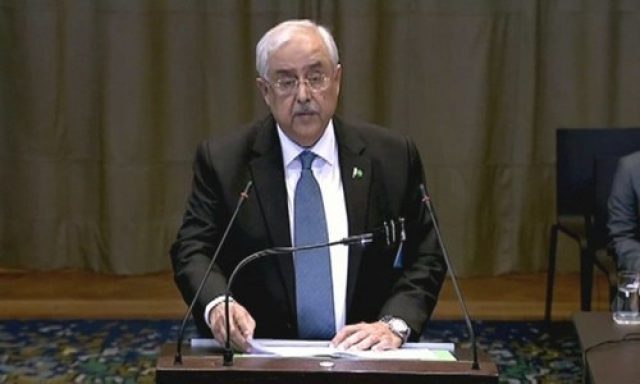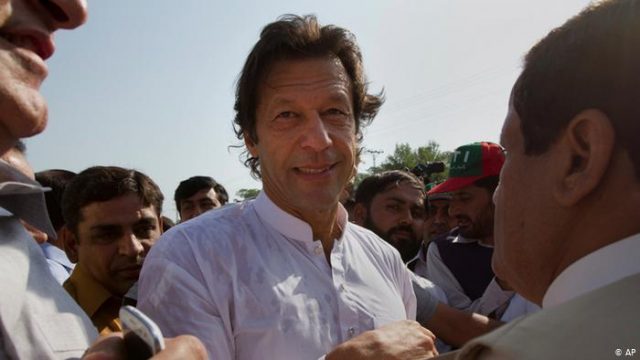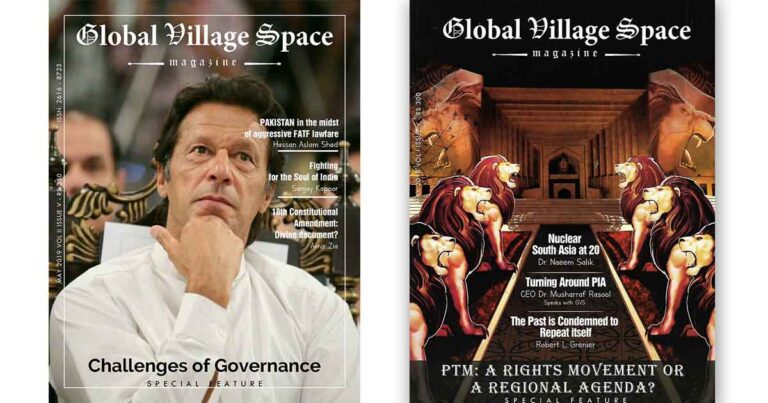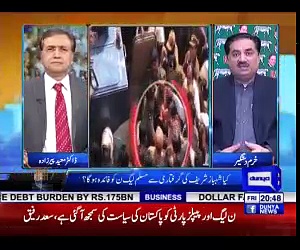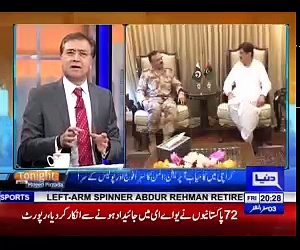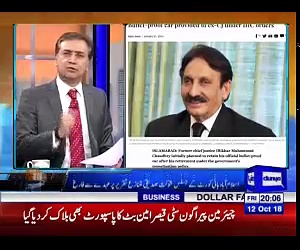Lawyers Movement or “Adlia Bahali Tehreek” (Restoration of Judiciary) occupies an important chapter in Pakistan’s colourful political history. Kickstarted on 9th March 2007, when the then Chief Justice, Iftikhar Mohammad Chaudhry was suspended by President Musharraf and later manhandled by a police officer outside his office, this movement continued in two phases (Mar-July 2007 & Nov 2007 to Mar 2009) lasting almost two years formally ending on 16th March 2009 when Iftikhar Chaudry was reinstated the second time – this time reluctantly by President Asif Ali Zardari.
Only twelve years have passed since its sudden eruption, (March 2007) and its too early for a meaningful nuanced cool-headed analysis of what lead to it and what was achieved or not achieved in those months of turbulence.
Iftikhar Chaudhry because of his peculiar personality – more akin to an action prone police officer than a sophisticated thinking judge of a top court – converted Supreme Court into a populist institution, a bold messiah deriving support from the street and the media.
Most characters who played an active part in pushing forward Lawyer’s Movement or fighting against it are still around with their strong opinions making it difficult for a balanced historical evaluation. But there is no denying whatever camp one may belong to, that the movement transformed Pakistani politics, media, civil society, and led to the emergence of a powerful assertive judiciary – the latter with all its advantages and disadvantages.
Iftikhar Chaudhry because of his peculiar personality – more akin to an action prone police officer than a sophisticated thinking judge of a top court – converted Supreme Court into a populist institution, a bold messiah deriving support from the street and the media. This is a trend which still continues, or resurfaces after brief interruptions, and many in the top court want to apply brakes and exorcise this “Chaudhry spirit” – the struggle continues.
On the positive side judicial assertiveness has created a life of its own. In today’s Pakistan, governments, political parties, media, elite sections of society and the establishment all have to be mindful of the presence of courts, especially the Supreme Court and the common man has developed a feeling and a belief – maybe exaggerated – that he has a recourse to some sort of justice in the form of the Supreme Court.
The same belief, in turn, creates populist pressures on the judges and temptations for the court to intervene in areas where normally courts should not venture into. It has become two-way traffic – a situation now unique to Pakistan. All this would not have been possible without the lawyer’s movement. However, one may ask: if the quality of judicial work or dispensation of justice has improved? Apparently, there is not much evidence to be hopeful.
Most characters who played an active part in pushing forward Lawyer’s Movement or fighting against it are still around with their strong opinions making it difficult for a balanced historical evaluation.
More than 1.9 million cases are pending before courts at all levels and more than 41,000 cases are pending before supreme court alone. Legal fees have mounted, most top lawyers demand fees in an arbitrary fashion, and are allegedly taking most of their fees as cash; there is no concept of “hourly or daily work fees” and most lawyers will not bill their clients explaining the legal work and legal hours spent – as is the common practice in the western countries.
In general, Lawyer’s movement has been seen, understood and described by media through an overly romanticized lens: and this mix of romance, idealism and Pakistan’s customary love for hagiography compels us to believe that it was a messianic movement by the lawyers and bar associations against a dictator, for democracy and justice.
This overly romanticized narrative pushed down repeatedly and forcefully through television, print and social media has made it impossible, for most Pakistanis, to appreciate the underlying political currents and the dynamics that were shaping it from inside and outside; simply put: who was fighting whom and why, and who won in the end is still not clear to most.
Christopher Marlowe, in Doctor Faustus (in late 16th century) referring to Helen of Troy, or as Marlowe had it ‘Helen of Greece’ had made his famous comment:
Was this the face that launch’d a thousand ships
And burnt the topless towers of Ilium?
Sweet Helen, make me immortal with a kiss.
Lawyers Movement: Power of an Image?
Like the “face that launched a thousand ships” immortalized in Homer’s unforgettable Illiad, perhaps the single most important element that kick-started Pakistan’s Lawyer’s Movement was an iconic image. The abduction of Helen of Sparta, daughter of Zeus and Leda and wife of Menelaus by Paris of Troy was an act of dishonor and treachery and the rivalry of Greek city-states was legendary but what launched the thousand ships was a beautiful face – Homer describes her as the most good looking woman on earth.
Musharraf’s act of suspending the Chief Justice may have been dictatorial, stupid or blatantly wrong but what suddenly united the disparate elements amongst the lawyers, the media and civil society was the shocking image of a tall bearded policeman grabbing country’s Chief Justice by his hair and pushing him to move in an ordered direction – rest is history.
In March of 2007, Musharraf was into eighth year of his arbitrary rule, his international allies – namely Washington blaming him for his “double games” in Afghanistan – wanted to ease him out from the scene, demands that he takes off his uniform were increasing, it was promised to be an election year and the Americans had already brokered a political deal – commonly referred to as NRO – between him and leader of PPP: Benazir Bhutto.
If everything had gone the way, it was planned then Musharraf and Bhutto had to become allies; with him as a civilian president and she as a popularly elected prime minister and both supporting Washington’s war in Afghanistan and maybe a rapprochement with India. There was one big catch: this scheme had no place for Nawaz Sharif who was expected to stay out (in London, as a concession) as per his ten-year contract with Musharraf, courtesy Saudis.
Reference meticulously traced and documented a series of acts that perfectly defined repeated and shameless influence peddling by Chaudhry for his son: Arsalan Iftikhar.
Musharraf, later in his TV interviews, generously admitted that suspension of Iftikhar Chaudhry was a mistake, perhaps he meant a ‘political mistake’ but that does not mean that his government wanted to get rid of Iftikhar Chaudhry because of judge’s purported corruption and abuse of office. Shaukat Aziz, the then Prime Minister, had turned against Iftikhar Chaudhry after latter’s meddling into the privatization of Pakistan Steel Mills – a loss-making entity that has gobbled up additional billions of rupees since then.
Musharraf, who was planning a transition along with Benazir Bhutto, (and wanted to keep his uniform till the last moment) was afraid that Chaudhry will do something to throw a spanner in the whole process. Whether Musharraf and his apparatchiks were merely paranoid or Chaudhry was indeed working on an agenda, from somewhere, is not clear – not to this day.
In his two reincarnations as Chief Justice of Pakistan, Chaudhry emerged as a strong political ally of Nawaz Sharif playing a crucial role in latter’s political rehabilitation; but its not clear if this alignment was due to Nawaz’s steadfast support for his two reinstatements – especially the second in March of 2009 – or there was a silent nexus between them before March of 2007.
Presidential Reference had bite and Substance?
While Musharraf’s quest to sideline Iftikhar Chaudhry was patently dishonest and self-serving, the Presidential Reference his team filed with Supreme Judicial Council against Chaudhry for abuse of office had serious elements of truth. Reference meticulously traced and documented a series of acts that perfectly defined repeated and shameless influence peddling by Chaudhry for his son: Arsalan Iftikhar.
Reference described an incompetent son – who failed civil services exams three times – now riding on his father’s powerful shoulders, ended up becoming Deputy Director FIA, in BPS-18, only to manufacture a back door lateral entry into Police Service of Pakistan. If the Supreme Judicial Council had been able to apply a dispassionate mind to the reference, and its detailed evidence, history of Pakistan might have been different.
Most characters who played an active part in pushing forward Lawyer’s Movement or fighting against it are still around with their strong opinions making it difficult for a balanced historical evaluation.
But the political pressures and “moral paradigm” generated by lawyer’s movement on streets and on media screens made it impossible for Supreme Judicial Council to even move in that direction – and the Supreme Court threw out the presidential reference as it reinstated Iftikhar Chaudhry as Chief Justice of Pakistan through a larger bench decision on 20th July, 2007.
For serious students of law and history, this decision will remain a purely political decision – dictated by the winds of populism emanating from the street, bar and TV screens. If first reinstatement looked like a constitutional decision, an application of judicious minds the second reinstatement had no such fictional cover; it was forced upon President Asif Zardari through a political gimmick in which Pakistan’s military establishment sided with Nawaz Sharif who threatened a march onto Islamabad.
Few years later, Arsalan Iftikhar, Chaudhry’s son, was again in the center of a dirty corruption scandal when country’s biggest property tycoon, Malik Riaz, accused Chief Justice and his son of blackmail and harassment.
Iftikhar Chaudhry and his supporters again declared this as a conspiracy against the Supreme Court, and Chaudhry as Chief Justice of Pakistan set up a panel to become the judge in his son’s case – in Pakistan’s farcical political theatre he was able to bail himself and his son from criminal charges but his erstwhile legendary reputation – his larger than life persona – never recovered from this episode.
Leaders and the Strategist?
Many figures are credited for the success of the lawyer’s movement. Munir A Malik the then President of prestigious Supreme Court Bar Association (SCBA), Ali Ahmed Kurd, the firebrand lawyer from Baluchistan, Hamid Khan the suave author of books on constitutional history, Athar Minallah, now Chief Justice of Islamabad High Court and so on. All contributed to the cause in their own ways.
But none can take away the shine from one man who single-handedly defined the political strategy that created the vertical pressures on the court from the street and the bar. Barrister Aitzaz Ahsan, former Interior Minister in Bhutto government, was the one who decided that while a suspended Chief Justice cannot address public rallies he can address the country’s bar associations.
For serious students of law and history, this decision will remain a purely political decision – dictated by the winds of populism emanating from the street, bar and TV screens.
Aitzaz’s clever strategy took the form of deliberately delayed long processions and rallies across GT road; an unusually supportive media multiplied the effect and all political parties jumped in for their own reasons. But for political parties, it was a cautious alliance against Musharraf in an election year. As soon as Musharraf was out of the way, after the Feb 2008 elections, PPP and its allies – ANP and JUI(F) etc. – broke ranks with PMLN that remained steadfast till the second coming of Iftikhar Chaudhry in March 2009.
In her life, Benazir made public gestures of support for Iftikhar Chaudhry calling him “our Chief Justice” and PPP leaders – just like PMLN – were visible alongside the lawyers and civil society activists but any off the record discussions with PPP leaders made it obvious that PPP was in to deny total space to PMLN and to maintain appearances; from the beginning PPP leaders – lead by Benazir Bhutto – were clear that Lawyer’s Movement was a spanner in the transition of power, and is a natural ally of PMLN and Nawaz spoke at London School of Economics in late summer of 2007.
He was being received and celebrated as the architect of the Lawyers Movement. During the Q&A session, this scribe asked him in public that “while he has met Nawaz and Shahbaz Sharif in London, he has not met his own party leader, Benazir Bhutto who also happened to be in London at the moment?” and he responded that “She perhaps does not want to meet him”.
Later, the same evening, on a private dinner he confessed that Benazir was not happy by his overt role in Lawyer’s Movement. There should be no ambiguity that Benazir Bhutto saw “Lawyers Movement” as a problem. This pre-existing fault line, between PPP and PMLN, opened up to become the clear battle line when after the Bhurban Accord of March 2009, PPP under Zardari backed out from the reinstatement of what he perceived and at times called “Chaudhry Court”
Black Coats Supported by Black Cameras, Why?
Could lawyers movement have succeeded without the support of TV channels? The answer is a resounding No. So were TV channels testing their newfound power against the state or was there someone pushing them, encouraging them from behind the scenes? There are many theories – especially with respect to some key media tycoons – but there is no clarity on this issue either.
On 12th May 2007, Karachi saw a bloodbath when MQM forcibly and mischievously tried to subvert the rally of Iftikhar Chaudhry, supported by other parties – mostly PPP. Fifty people died, on that day with TV channels showing wounded and the dying, blood gushing from injured bodies and twisted torsos lay on the streets. It was the darkest spot in Musharraf’s otherwise decent legacy for it was obvious that whatever MQM did was to support Musharraf – and perhaps on his behest.
Hamid Khan the suave author of books on constitutional history, Athar Minallah, now Chief Justice of Islamabad High Court and so on. All contributed to the cause in their own ways.
And Lawyers movement definitely emerged as a real movement graduating from synthetic anger of TV screens onto the streets with blood and tears. But despite this, it will be a gross exaggeration to tell the student of Pakistan’s history that lawyer’s movement finished off Musharraf. He was definitely weakened, looked vulnerable and lost his moral authority but the lawyer’s moment was never a movement of the masses, it could not give a mortal blow.
That hatchet job was done by another tragedy of Pakistan’s troubled history: Lal Masjid. Army’s raid into the controversial mosque in the center of Islamabad, near Aabpara, to clear it from vigilante students and militants led to almost a hundred deaths including 10 soldiers and many girl students.
This human disaster and its exaggerated presentation by media (media that initially demanded action against the Lal Masjid) and rumour mills that talked of hundreds of deaths of poor female students melted the politics of PMLQ, Musharaf allies, in all northern Punjab.
Nawaz Sharif’s re-entry riding again on Saudi coattails and his cautiously anti-American, nationalistic campaign and Benazir’s assassination set the stage for Musharraf’s exit from the scene. As briefly referred above, Aitzaz and Chaudhry’s odyssey and that of the black coats did not finish with 2008 elections.

Musharraf had again removed Chaudhry on Nov 3, 2007 when he imposed emergency and introduced a most controversial, Provisional Constitutional Order (PCO) that removed dozens of judges including Iftikhar Chaudhry and many brother judges that supported him on a point of principle against his emergency.
Its difficult to guess what would have happened in the January 2018 elections – as those were earlier planned – had Lal Masjid fiasco and Benazir’s tragic assassination not happened. But history is etched in stone so we will never know.
What we know is that PPP ended up forming a government in the Center and Sindh and PMLN ended up controlling Punjab. Nawaz and Zardari, meeting in the salubrious Pearl Continental on the hills above Islamabad, struck the famous Bhurban Accord in March of 2008. The most important clause was the restoration of deposed judges.
Zardari’s Refusal to Reinstate the court, why?
But Zardari, like Benazir, suspected that restoration of a court lead by Iftikhar Chaudhry will work against his political interests – as it will emerge as an ally of Nawaz. Next 12 months saw promises, denials, negotiations and foot-dragging. PMLN that was briefly part of the central government left on high moral ground – restoration of the real supreme court.
But the final restoration came when Zardari and his point man in Lahore, Governor Salman Taseer, blundered into removing PMLN from power in Punjab –and upsetting the apple cart of Pakistani politics. Nawaz was put against the wall, and military establishment led by General Kayani played behind the scenes to restore the balance of power.
The answer is a resounding No. So were TV channels testing their newfound power against the state or was there someone pushing them, encouraging them from behind the scenes?
A hurriedly assembled crowd, an ocean of humanity – an over imaginative replay of French or Soviet revolution, courtesy TV channels- was set into motion marching as a figure of speech from Lahore onto Islamabad.
The created spectre of an indefensible Islamabad to be ravaged by hooligans and barbarians from Lahore, their numbers swelling from all over Punjab was sold and oversold by print media and TV channels; a panicked Zardari, under pressure from the military establishment, agreed to the second restoration of Iftikhar Chaudhry and his brother judges.
Much has been made of the famous phone call from GHQ, that went to Aitzaz Ahsan to request a halt – and rest is history. In hindsight, after witnessing several later marches onto Islamabad by political fanatics of Qadri, (2013 & 2014) urban crowds of PTI (2014 & 2016) and religious zealots of TLP (2017 & 2019) one can safely conclude that the panic that was created in March 2009 was a choreographed hoax to achieve results-perhaps a balance of power.
Islamabad at the beginning of the 21st century is not 5th century Rome besieged by Gauls and Visigoths and other Germanic barbarians; its determined police and rangers are sufficient to hold onto –and perhaps beat – any kind of political or religious adventurists. It’s a matter of will not capacity; though this aspect was less understood by public and media in 2009 that facilitated the prank played by General Kayani and his team.
Nawaz was put against the wall, and military establishment led by General Kayani played behind the scenes to restore the balance of power.
Supreme Court under Iftikhar Chaudhry played the role, Zardari had feared. Decisions of the court helped rehabilitate Nawaz’s politics and kept PPP in the center under constant pressure.
A section of the media aligned itself with Punjab government and the court; select reporters used to bring out front page stories of corruption by PPP ministers and the court instituted ‘suo moto notices’ – cases would continue for months often without any results. The assertiveness of the courts was matched by the hooliganism of lawyers across the country who in many instances went on thrashing the judges.
Many zealots of the Lawyers Movement, despite limited caliber, were elevated to the bench as high court judges – one of them was Justice Shaukat Siddique who was finally removed in 2018 by Supreme Judicial Council. But there were others.
The presence of incompetent, pedestrian sounding zealots – who commented upon matters more like SHO’s rather than the intellectually driven characters’ judges ought to be – has done much to lower the prestige of high court benches.
Gradually courts, lead by Supreme Court and supported by the leadership of the bar councils went on a course correction – that process still continues; address of new Chief Justice, Asif Saeed Khosa, at the full court reference, in January of 2019, was thus very inspiring.

But despite these various failings, Lawyers Movement remains an important chapter of Pakistan’s political journey that did much in giving confidence to the lawyers, students, civil society activists, media professionals and educated citizens that arbitrary power of the state can be challenged through the power of ideas and through peaceful agitation.
Movement established the principle that extra-constitutional adventurism will not be sustainable. Most leaders of the lawyer’s movement were later on bitter for one or the other reason, they fell apart and even turned against the erstwhile Chief Justice, Iftikhar Chaudhry; but the fact remains that movement and its gains were not possible without his peculiar personality – boldness and defiance was his natural gift.
